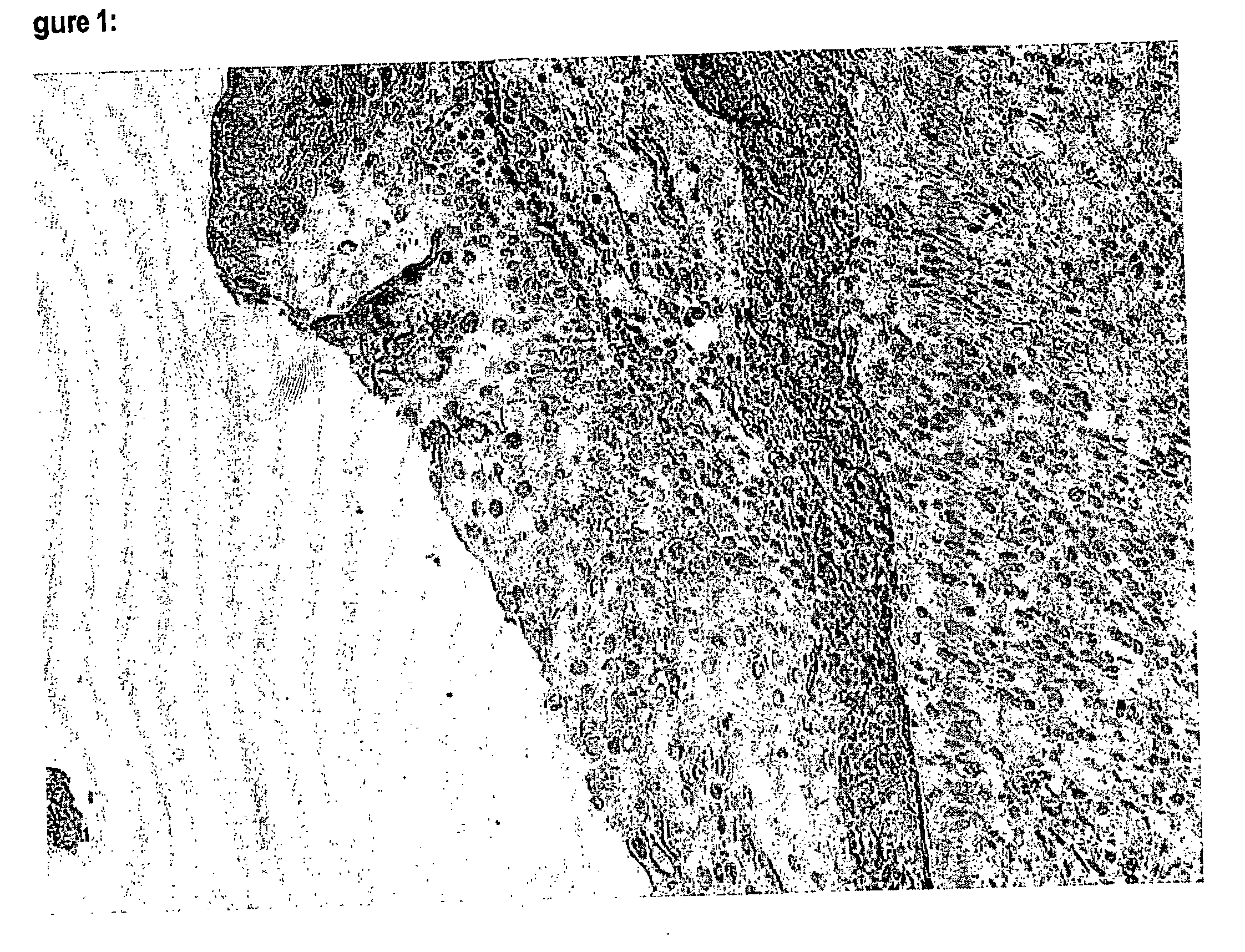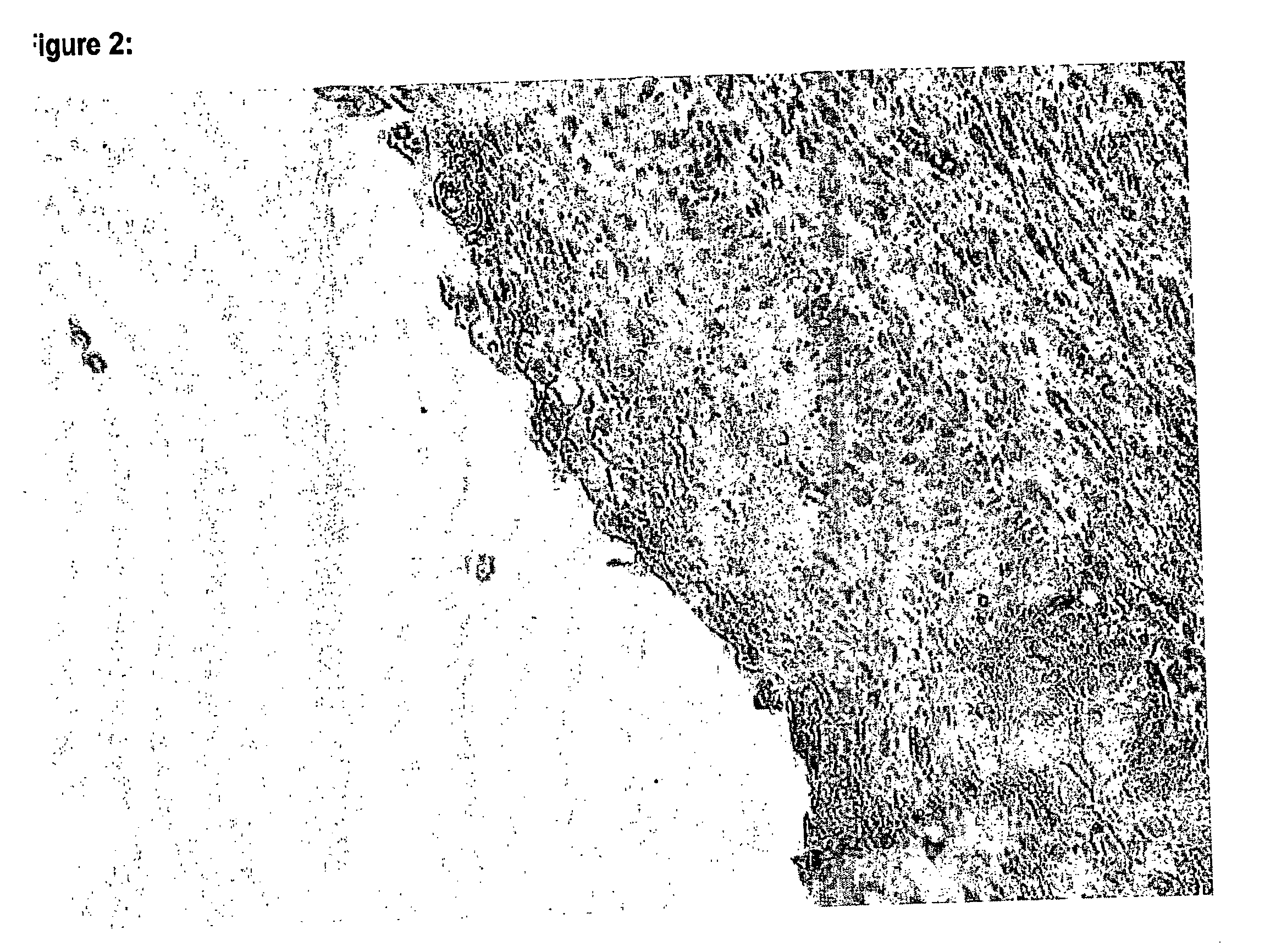Compositions and methods for diagnosis and therapy of cancers
a cancer and cancer technology, applied in the field of improved diagnosis of cervical lesions, can solve the problems of false positive, unpleasant condition, false positive,
- Summary
- Abstract
- Description
- Claims
- Application Information
AI Technical Summary
Problems solved by technology
Method used
Image
Examples
example 1
Immunochemical Detection of the Overexpression of p16INK4a and p14ARF in Samples of the Uterine Cervix
[0189] Sections of formalin fixed, paraffin embedded tissue samples of the cervix uteri were immunocytochemically stained using antibodies specific for p16INK4a and p14ARF.
[0190] The sections were rehydrated through incubation in xylene and graded ethanol, and transferred to Aqua bidest. Antigen retrieval was carried out with 10 mM citrate buffer (pH 6.0) for p16INK4a. Thereafter, the slides were heated in a waterbath for 40 min at 95° C. For p14ARF the slides were heated in 1 mmol EDTA (pH8.0) at 98° C. for 20 min. The slides were cooled down to room temperature (RT) for 20 minutes, transferred to washing buffer (PBS / 0.1% Tween20) and finally the tissue sections were surrounded with a lipid-pencil.
[0191] For inactivation of endogenous peroxidase, the samples were incubated with 3% H2O2 for 20 min at RT and afterwards washed in PBS / 0.1% Tween20 for 5 to 10 min.
[0192] The slides ...
example 2
Detection of Cells Expressing p14ARF or p16INK4a in Samples of the Uterine Cervix by In Situ Hybridization
[0197] Smears of the uterine cervix can be semi-quantitatively analysed for the mRNA level of p16INK4a and p14ARF in an in-situ staining reaction. The staining reaction is performed as follows:
[0198] For rehydration the spray-fixed smears are incubated in fresh 50% EtOH on a rocking device. The PEG film produced by the fixation procedure is removed by intensive rinsing. Then the smears are rinsed in aqua bidest. The smears are incubated with porteinase K (10 μg / ml in PBS) for 10 min at 37° C. Then the slides are transferred to washing buffer (PBS / 0.1% Tween20) and finally the area containing the cells is surrounded with a lipid-pencil.
[0199] The hybridization mixture is prepared by mixing 50 μl of ready to use hybridization buffer (DAKO A / S, Glostrup, Danmark) with about 5-10 pmol of the probes. The probes are fluorescein-labelled oligonucleotides of sequences complememtary t...
example 3
In Vitro Stimulation of Cellular Immune Response by HLA-A1 Restricted Peptides
[0204] The present experiments are performed in order to determine whether the peptides according to the present invention are suited to stimulate a cellular immune response. The experiments are performed as follows:
[0205] Peptides displaying HLA-A2.1-as well as HLA-A1 and HLA-A3-binding motifs are selected by taking advantage of specific computer programs [(Parker, Bednarek, & Coligan 1994); http: / / bimas.dcrt.nih.gov / molbio / hla_bind / and (Rammensee et al. 1999); http: / / 134.2.96.221 / scripts / MHCServer.dll / home.htm]. Peptides are purchased from the peptide synthesis unit of the DKFZ. Stock solutions (10 mg / ml in DMSO) are stored at −70° C. and diluted to 1 mg / ml in PBS before use.
[0206] In one representative experiment, T2 cells are pulsed with 7 p14ARF specific HLA-A2.1 restricted nonamer peptides (Pos. 51: MVRRFLVTL, Pos. 91: AAVALVLML, Pos. 92: AVALVLMLL, Pos. 97: LMLLRSQRL, Pos. 8: HIMGRGRCV, Pos. 85:...
PUM
| Property | Measurement | Unit |
|---|---|---|
| Immunogenicity | aaaaa | aaaaa |
| Fluorescence | aaaaa | aaaaa |
| Chemiluminescence | aaaaa | aaaaa |
Abstract
Description
Claims
Application Information
 Login to View More
Login to View More - R&D
- Intellectual Property
- Life Sciences
- Materials
- Tech Scout
- Unparalleled Data Quality
- Higher Quality Content
- 60% Fewer Hallucinations
Browse by: Latest US Patents, China's latest patents, Technical Efficacy Thesaurus, Application Domain, Technology Topic, Popular Technical Reports.
© 2025 PatSnap. All rights reserved.Legal|Privacy policy|Modern Slavery Act Transparency Statement|Sitemap|About US| Contact US: help@patsnap.com



